Cavernous Sinus Thrombosis Definition
Cavernous sinus thrombosis is a condition where a blood clot forms in the region under your brain and at the back of the eye socket. These clots obstruct the vein in the aforementioned area of your body. This condition is uncommon but a serious one and affects both children and adults. Studies have shown that cavernous sinus thrombosis accounts for about 30% of death cases3.
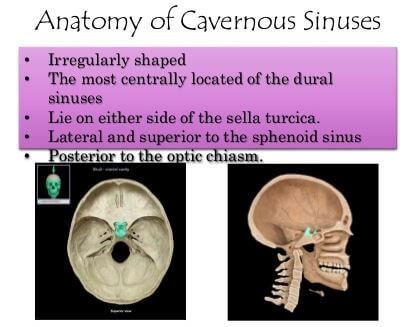
Image 1 – Anatomy of cavernous sinus
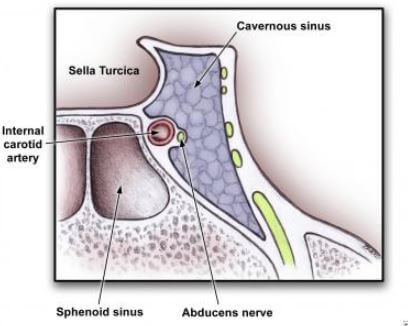
Image 2 – Location of Cavernous Sinus
Causes
This condition can result from the following causes1, 2, 4:
Infections
One major cause of this condition is infection. Microorganisms such as bacteria can cause infections in your teeth or any other part of your body which can spread into your brain. The following are sources of infections:
Infected gums
If your gums are infected, the infections can spread and affect your brain including cavernous sinuses.
Sinusitis
This infection affects small openings at the back of your forehead and cheekbones.
Boil
This is a painful red bump that occurs at the place of infected hair follicles.
Blood clots
Cavernous sinuses are cavities found below your brain and behind the eyes socket. There is a blood vessel known as jugular vein that transports blood via the cavernous sinus away from the brain. When the cavernous sinuses are infected, your immune system forms a blood clot to stop spread of microorganisms. The blood clot elevates the pressure in your brain thus damaging the brain cells.
Trauma to the head
Injury to the head can cause this condition. Trauma to the head may involve a road accident, being hit by a heavy object on the head or falling from a building. These traumas can damage blood vessels in your brain.
Risk Factors
There are several risk factors that can increase your chances of developing this condition. These risk factors are as follows1, 4:
Medications
Using particular drugs can increase your risk of getting this condition. For example if you use nonsteroidal anti-inflammatory drugs like aspirin, you are more prone to blood clots which can cause cavernous sinus thrombosis. Other drugs that can increase your chances of having blood clots include oral contraceptives and cancer treatment medications.
Medical conditions
Some health conditions can cause your blood to clot. For example pregnancy can elevate your chances of developing blood clots which can hurt your brain when they reach it. This mostly occurs in women. Medical conditions such as lupus can cause inflammation in your body thus causing cavernous sinus thrombosis.
Symptoms
You can know you have cavernous sinus thrombosis if you have the following signs and symptoms2:
- You have a severe headache. There is visible redness and swelling around both of your eyes which is accompanied by irritation. Your eyelids may sag or become droopy which makes it difficult for you to move the eye. Areas around your eyes and face can become numb or painful. You can experience double loss of vision. You can have fever and feel fatigued. Seizures are also common.
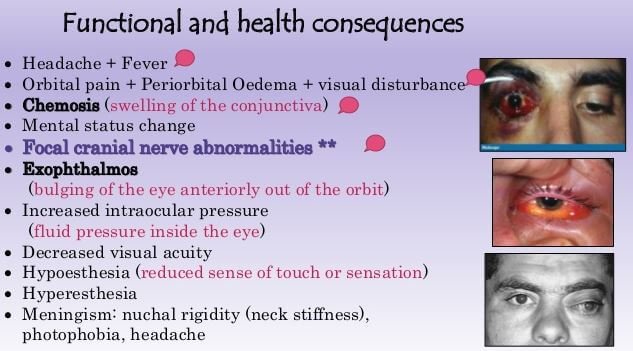
Image 3 – Clinical Signs & Symptoms of Cavernous Sinus Thrombosis
Diagnosis
There are several tests your doctor can order on your brain to diagnose this condition. These tests include1, 2:
Imaging tests
Your doctor can order several imaging scans on your brain to find out problems with blood vessels in the brain. Magnetic resonance imaging scan can be used to check for problems in your brain and its blood vessels. Computed tomography scans can provide detailed images of different parts of your brain which your doctor can evaluate to diagnose this condition.
Blood tests
Spinal fluid or blood tests can be ordered to find out if infections are causing cavernous sinus thrombosis. Your doctor will collect your blood and take a sample to evaluate it for pathogens such as bacteria. Alternatively, your doctor can drain out your spinal fluid and analyze it for any infections.
Treatment
Successful treatment for cavernous sinus thrombosis depends on treating the underlying causes and alleviating its symptoms. Medications and surgery can be used as treatment options1, 2, 3.
Medications
Your doctor can recommend various drugs to treat infections and lessen the symptoms. The following drugs can be prescribed:
Antibiotics
If your doctor identifies bacteria as the cause of infections leading to cavernous sinus thrombosis, antibiotics will be prescribed to treat it. The doctor will inject the antibiotics into your vein. Most people may need this medication for about two weeks in order to eliminate the infection completely.
Corticosteroid
Your doctor may administer corticosteroid. This form of medication can be used to lower swellings and inflammation in your body.
Anticoagulants
Your doctor may prescribe medications to eliminate blood clots. Anticoagulants such as heparin can be recommended to dissolve blood clots and stop them from forming.
Anticoagulants drugs provide relief to some people with cavernous sinus thrombosis.
Surgical drainage
Infection can arise from any part of your body and cause cavernous sinus thrombosis. Infections coming from sinusitis or boils can be treated by surgically draining them out. If it is a boil, your doctor may use a needle to drain it. For infected sinusitis, your doctor will conduct surgery to drain the fluid.
Complications
Cavernous sinus thrombosis is a life-threatening condition. It causes many deaths despite quick medical attention. For those who survive, some of them will have permanent health problems because of damage to their brain. They will experience severe and persistent headaches. They will also experience loss of vision2.
Pictures
Image 4 – Venous Sinus Vs Cavernous Sinus
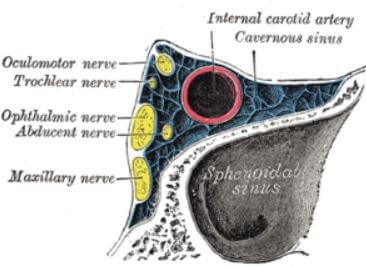
Image 5 – cavernous Sinus related to cranial nerves
When to Seek Medical Attention?
Cavernous sinus thrombosis is fatal if left untreated. You can prevent this condition from becoming life-threatening by monitoring your symptoms. You must seek urgent medical attention if you notice the following symptoms1:
- You are unable to move your eyes in one direction. Your eyes start to bulge and the eyelids begin to sag. You experience vision loss as well as pain in the eyes.
Reference List
- Cavernous sinus thrombosis. https://medlineplus.gov/ency/article/001628.htm
- http://www.webmd.com/a-to-z-guides/cavernous-sinus-thrombosis
- http://www.nhs.uk/Conditions/Cavernous-sinus-thrombosis/Pages/Introduction.aspx
- Blood clots. Available at http://www.mayoclinic.org/symptoms/blood-clots/basics/causes/sym-20050850

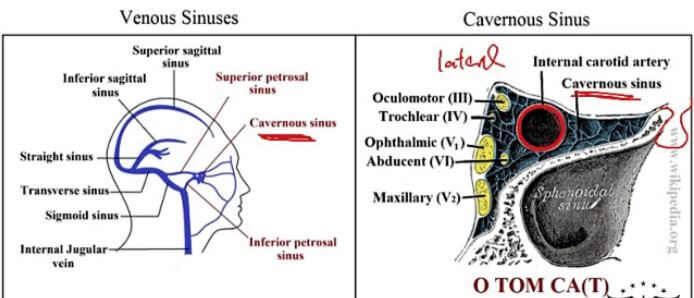
I have Progressive MS and Autoimmune Hepatitis and have been feeling really I’ll. I’ve had extremely bad headaches, blurred vision and dizziness so my neurologist sent me in for a new MRI and I was was diagnosed with Sinus Thrombosis two days later on a Thursday. They set me up for two more MRIs the following Thursday because the technician stated that she wasn’t told it was urgent or less Fe threatening and since I’m so sick I’m scared I won’t make it. I also don’t have any fever to suggest an infection nor have I ever bumped my head. Do you have any suggestions on how to handle this anyone? Thank you!
Sherry